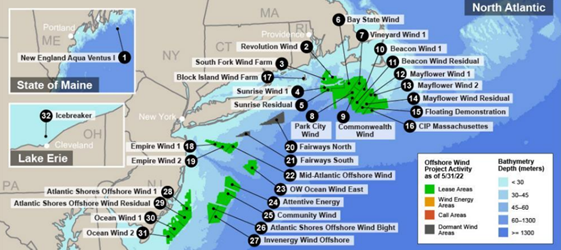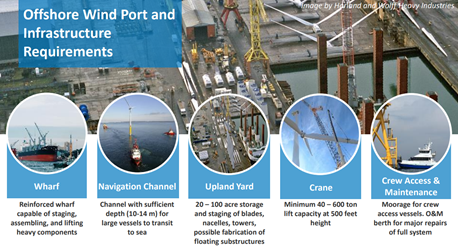The potential off-shore wind market in the U.S. is estimated to be two times the current U.S. electric energy use and the North Atlantic region is poised play a big part in an industry that’s expected to create thousands of related manufacturing and maritime jobs.
The Metropolitan Area Planning (MAP) Forum’s Multi-State Freight Working Group recently hosted an online workshop, “Off-Shore Wind Development Needs and Implications for Regional Planning and Transportation.” A recording of the workshop is available here.
The MAP Forum, created in 2008, is a consortium of 10 Metropolitan Planning Organizations (MPOs) and Councils of Government (COGs) from Connecticut, New Jersey, New York and Pennsylvania which coordinate planning activities in the multi-state region.
Panelists presented updates on off-shore wind developments as well as off-shore wind workforce initiatives. The panel included:
- Matt Shields, senior off-shore wind analyst, National Renewable Energy Laboratory (NREL)
- Max Taffett, maritime and port planner, New York City Economic Development Authority
- Geoffrey Storr, manager, infrastructure division, New Jersey Economic Development Authority (NJEDA)
- David Kooris, Chair of the Board of the Connecticut Port Authority
- Julia Kortney, manager, NJEDA, New Jersey Wind Institute
 "The off-shore wind market and industry is really ramping up and accelerating,” Shields said. The Biden administration has set a goal to install 30 gigawatts by 2030. There are about 40,000 megawatts (MW) of policy commitments by eight eastern states and a comparable amount in the pipeline. But so far just seven turbines, generating 42 megawatts, have been installed.
"The off-shore wind market and industry is really ramping up and accelerating,” Shields said. The Biden administration has set a goal to install 30 gigawatts by 2030. There are about 40,000 megawatts (MW) of policy commitments by eight eastern states and a comparable amount in the pipeline. But so far just seven turbines, generating 42 megawatts, have been installed.
To reach that 30 GW goal by 2030 would require more than 2,000 wind turbines in U.S. waters and an estimated capital expenditure of more than $100 billion.
The challenge is that global supply chains are at capacity so a domestic supply chain would be needed to help reach these targets. The components for off-shore wind projects are so big that most any port in the U.S. will need significant upgrades, including deeper changes, massive heavy-lift cranes and large upland yards.
 The New Jersey Wind Port in Lower Alloways Creek is the first purpose-built wind port in the U.S. Construction has begun and the first phase is expected to be completed in 2024 and continue into 2028 while creating up to 1,500 manufacturing and operations jobs. The 220 acres of developable land is not constrained by bridges and co-locating with manufacturing and marshalling to avoid extra transportation of components. “If you don’t have marshalling space, you can’t attract the supply chain; these are key areas,” said Storr.
The New Jersey Wind Port in Lower Alloways Creek is the first purpose-built wind port in the U.S. Construction has begun and the first phase is expected to be completed in 2024 and continue into 2028 while creating up to 1,500 manufacturing and operations jobs. The 220 acres of developable land is not constrained by bridges and co-locating with manufacturing and marshalling to avoid extra transportation of components. “If you don’t have marshalling space, you can’t attract the supply chain; these are key areas,” said Storr.
Kooris described off-shore wind industry as an ecosystem, particularly in New England when so many states are in close proximity working together. “This is not going to be each state on their own but together with collective infrastructure and collective purchasing, will grow this industry for the benefit of us all.”